Nursing Health Assessment: Developing Interview Skills for Better Care
VerifiedAdded on 2023/04/11
|7
|1236
|355
Essay
AI Summary
This essay explores the development of essential health assessment and interviewing skills in nursing students. It emphasizes the importance of patient interviews in gathering crucial medical history and enhancing diagnostic accuracy. The paper discusses key aspects of effective patient interviewing, including creating a comfortable environment, active listening, and using clear language. It further delves into the processing of collected information, highlighting interpretation, discrimination, relating, inferring, matching, and prediction as critical components of clinical reasoning and judgment. The essay concludes that practical experience in interviewing patients is vital for developing critical thinking, clinical reasoning, and sound judgment in nursing practice. Desklib offers a wealth of resources, including similar solved assignments and past papers, to support students in their nursing education.
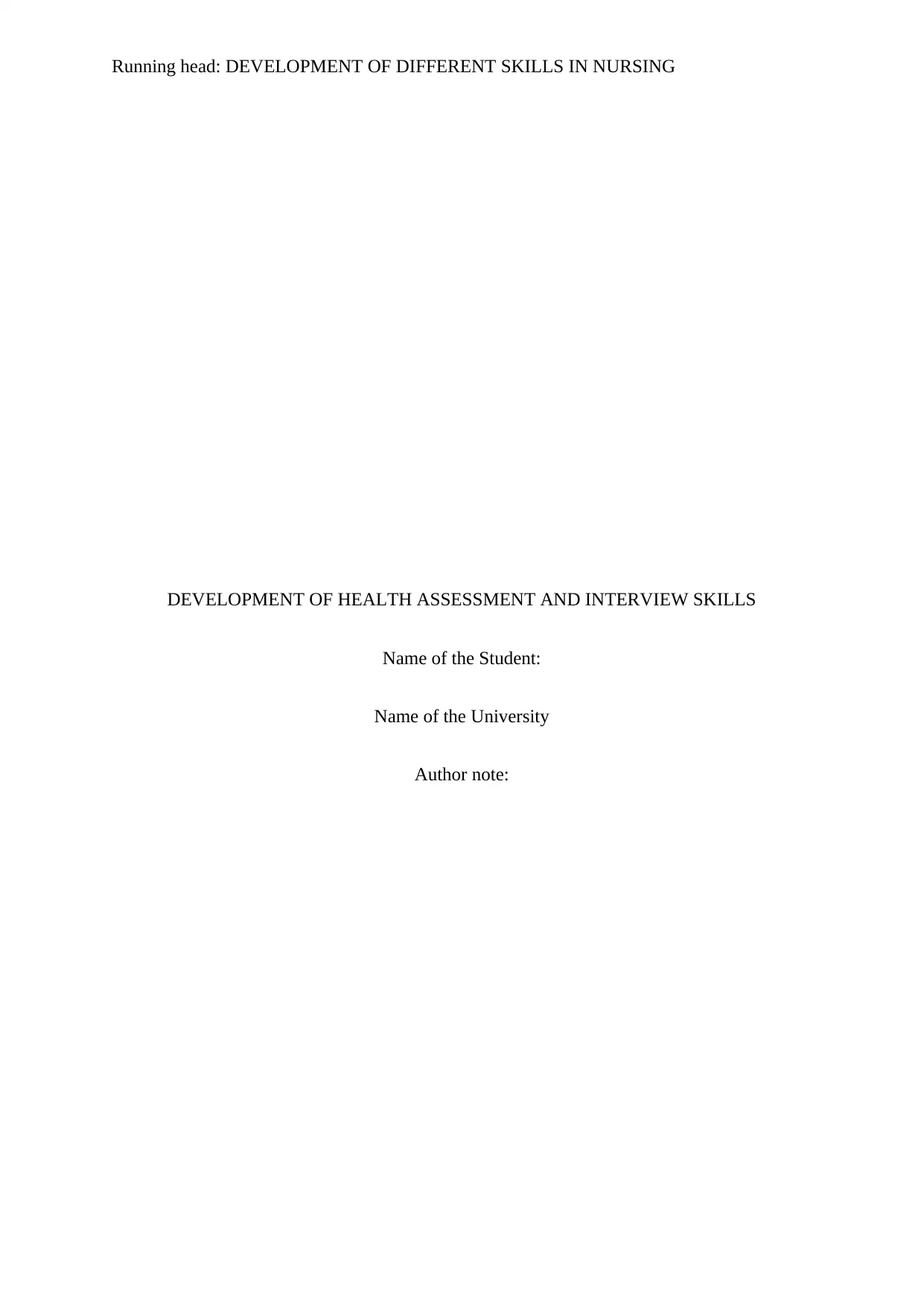
Running head: DEVELOPMENT OF DIFFERENT SKILLS IN NURSING
DEVELOPMENT OF HEALTH ASSESSMENT AND INTERVIEW SKILLS
Name of the Student:
Name of the University
Author note:
DEVELOPMENT OF HEALTH ASSESSMENT AND INTERVIEW SKILLS
Name of the Student:
Name of the University
Author note:
Paraphrase This Document
Need a fresh take? Get an instant paraphrase of this document with our AI Paraphraser
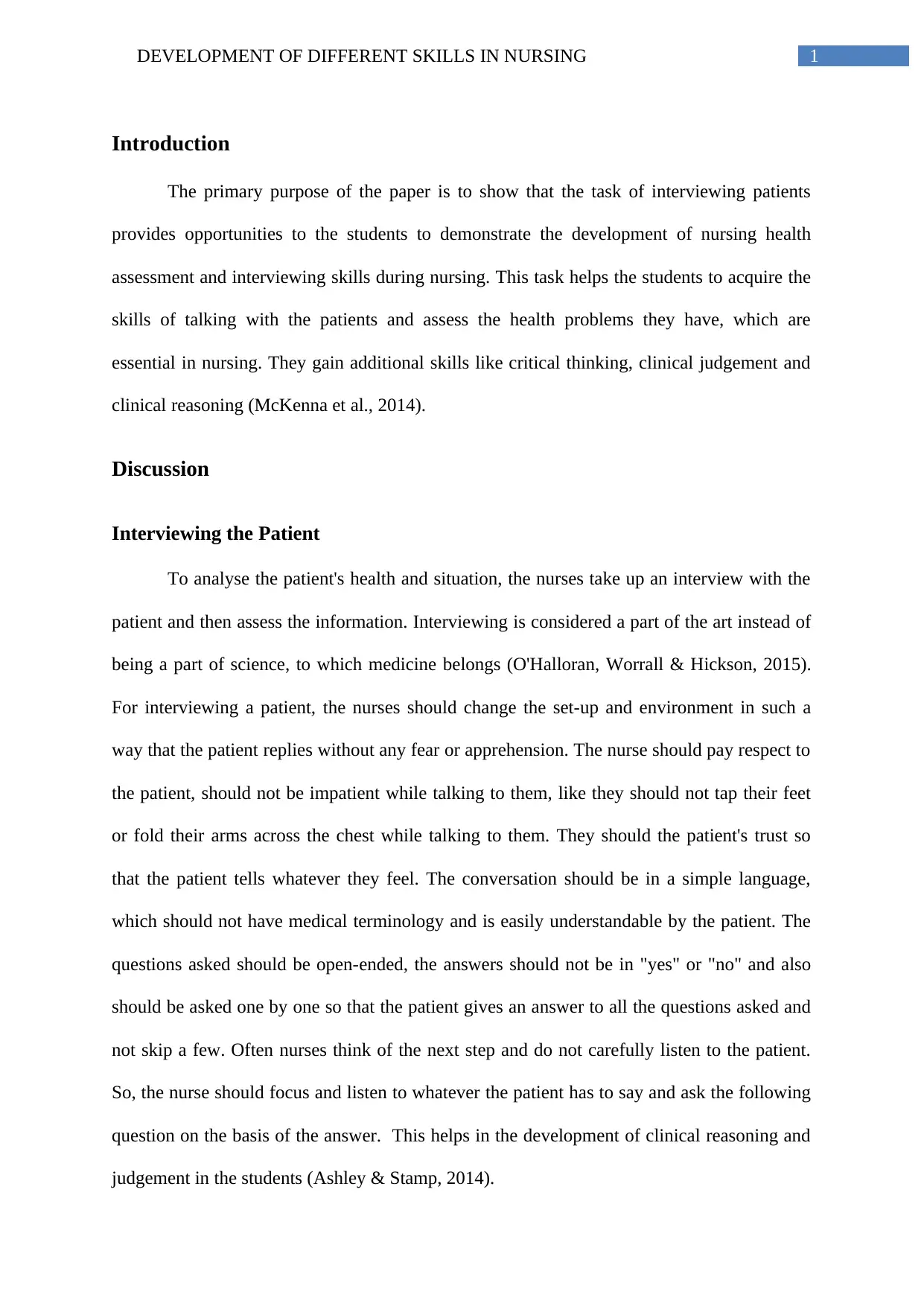
1DEVELOPMENT OF DIFFERENT SKILLS IN NURSING
Introduction
The primary purpose of the paper is to show that the task of interviewing patients
provides opportunities to the students to demonstrate the development of nursing health
assessment and interviewing skills during nursing. This task helps the students to acquire the
skills of talking with the patients and assess the health problems they have, which are
essential in nursing. They gain additional skills like critical thinking, clinical judgement and
clinical reasoning (McKenna et al., 2014).
Discussion
Interviewing the Patient
To analyse the patient's health and situation, the nurses take up an interview with the
patient and then assess the information. Interviewing is considered a part of the art instead of
being a part of science, to which medicine belongs (O'Halloran, Worrall & Hickson, 2015).
For interviewing a patient, the nurses should change the set-up and environment in such a
way that the patient replies without any fear or apprehension. The nurse should pay respect to
the patient, should not be impatient while talking to them, like they should not tap their feet
or fold their arms across the chest while talking to them. They should the patient's trust so
that the patient tells whatever they feel. The conversation should be in a simple language,
which should not have medical terminology and is easily understandable by the patient. The
questions asked should be open-ended, the answers should not be in "yes" or "no" and also
should be asked one by one so that the patient gives an answer to all the questions asked and
not skip a few. Often nurses think of the next step and do not carefully listen to the patient.
So, the nurse should focus and listen to whatever the patient has to say and ask the following
question on the basis of the answer. This helps in the development of clinical reasoning and
judgement in the students (Ashley & Stamp, 2014).
Introduction
The primary purpose of the paper is to show that the task of interviewing patients
provides opportunities to the students to demonstrate the development of nursing health
assessment and interviewing skills during nursing. This task helps the students to acquire the
skills of talking with the patients and assess the health problems they have, which are
essential in nursing. They gain additional skills like critical thinking, clinical judgement and
clinical reasoning (McKenna et al., 2014).
Discussion
Interviewing the Patient
To analyse the patient's health and situation, the nurses take up an interview with the
patient and then assess the information. Interviewing is considered a part of the art instead of
being a part of science, to which medicine belongs (O'Halloran, Worrall & Hickson, 2015).
For interviewing a patient, the nurses should change the set-up and environment in such a
way that the patient replies without any fear or apprehension. The nurse should pay respect to
the patient, should not be impatient while talking to them, like they should not tap their feet
or fold their arms across the chest while talking to them. They should the patient's trust so
that the patient tells whatever they feel. The conversation should be in a simple language,
which should not have medical terminology and is easily understandable by the patient. The
questions asked should be open-ended, the answers should not be in "yes" or "no" and also
should be asked one by one so that the patient gives an answer to all the questions asked and
not skip a few. Often nurses think of the next step and do not carefully listen to the patient.
So, the nurse should focus and listen to whatever the patient has to say and ask the following
question on the basis of the answer. This helps in the development of clinical reasoning and
judgement in the students (Ashley & Stamp, 2014).
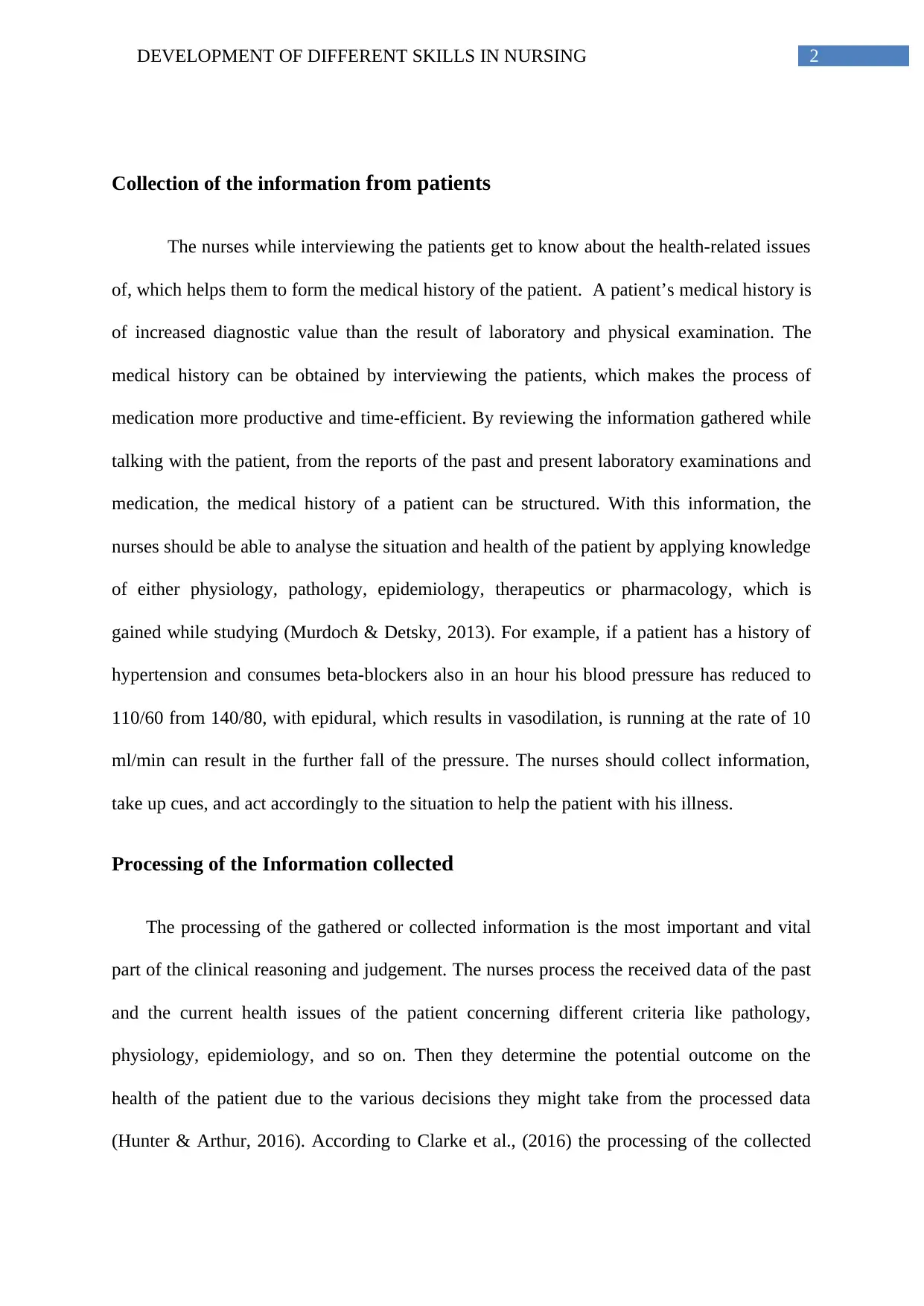
2DEVELOPMENT OF DIFFERENT SKILLS IN NURSING
Collection of the information from patients
The nurses while interviewing the patients get to know about the health-related issues
of, which helps them to form the medical history of the patient. A patient’s medical history is
of increased diagnostic value than the result of laboratory and physical examination. The
medical history can be obtained by interviewing the patients, which makes the process of
medication more productive and time-efficient. By reviewing the information gathered while
talking with the patient, from the reports of the past and present laboratory examinations and
medication, the medical history of a patient can be structured. With this information, the
nurses should be able to analyse the situation and health of the patient by applying knowledge
of either physiology, pathology, epidemiology, therapeutics or pharmacology, which is
gained while studying (Murdoch & Detsky, 2013). For example, if a patient has a history of
hypertension and consumes beta-blockers also in an hour his blood pressure has reduced to
110/60 from 140/80, with epidural, which results in vasodilation, is running at the rate of 10
ml/min can result in the further fall of the pressure. The nurses should collect information,
take up cues, and act accordingly to the situation to help the patient with his illness.
Processing of the Information collected
The processing of the gathered or collected information is the most important and vital
part of the clinical reasoning and judgement. The nurses process the received data of the past
and the current health issues of the patient concerning different criteria like pathology,
physiology, epidemiology, and so on. Then they determine the potential outcome on the
health of the patient due to the various decisions they might take from the processed data
(Hunter & Arthur, 2016). According to Clarke et al., (2016) the processing of the collected
Collection of the information from patients
The nurses while interviewing the patients get to know about the health-related issues
of, which helps them to form the medical history of the patient. A patient’s medical history is
of increased diagnostic value than the result of laboratory and physical examination. The
medical history can be obtained by interviewing the patients, which makes the process of
medication more productive and time-efficient. By reviewing the information gathered while
talking with the patient, from the reports of the past and present laboratory examinations and
medication, the medical history of a patient can be structured. With this information, the
nurses should be able to analyse the situation and health of the patient by applying knowledge
of either physiology, pathology, epidemiology, therapeutics or pharmacology, which is
gained while studying (Murdoch & Detsky, 2013). For example, if a patient has a history of
hypertension and consumes beta-blockers also in an hour his blood pressure has reduced to
110/60 from 140/80, with epidural, which results in vasodilation, is running at the rate of 10
ml/min can result in the further fall of the pressure. The nurses should collect information,
take up cues, and act accordingly to the situation to help the patient with his illness.
Processing of the Information collected
The processing of the gathered or collected information is the most important and vital
part of the clinical reasoning and judgement. The nurses process the received data of the past
and the current health issues of the patient concerning different criteria like pathology,
physiology, epidemiology, and so on. Then they determine the potential outcome on the
health of the patient due to the various decisions they might take from the processed data
(Hunter & Arthur, 2016). According to Clarke et al., (2016) the processing of the collected
⊘ This is a preview!⊘
Do you want full access?
Subscribe today to unlock all pages.

Trusted by 1+ million students worldwide
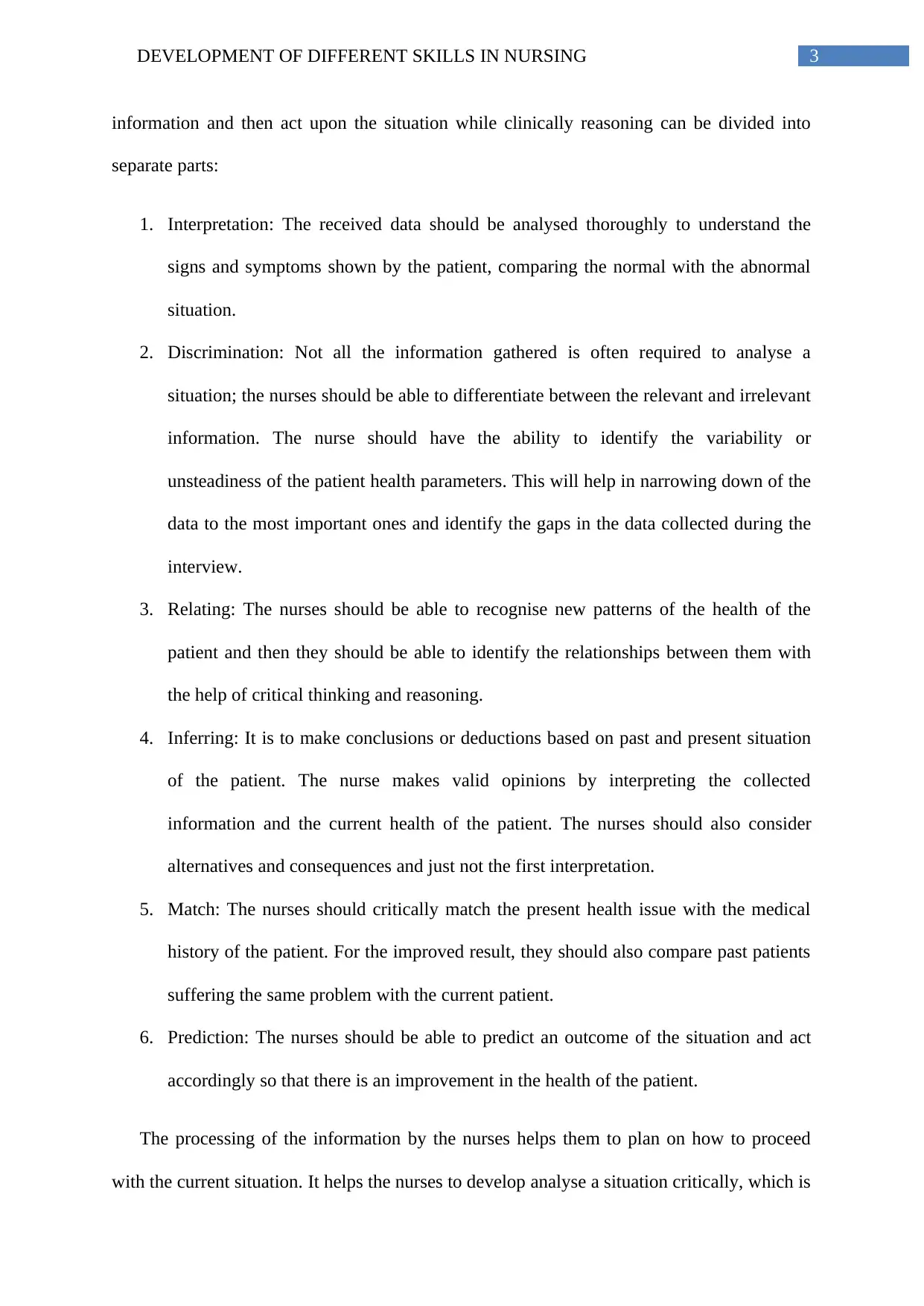
3DEVELOPMENT OF DIFFERENT SKILLS IN NURSING
information and then act upon the situation while clinically reasoning can be divided into
separate parts:
1. Interpretation: The received data should be analysed thoroughly to understand the
signs and symptoms shown by the patient, comparing the normal with the abnormal
situation.
2. Discrimination: Not all the information gathered is often required to analyse a
situation; the nurses should be able to differentiate between the relevant and irrelevant
information. The nurse should have the ability to identify the variability or
unsteadiness of the patient health parameters. This will help in narrowing down of the
data to the most important ones and identify the gaps in the data collected during the
interview.
3. Relating: The nurses should be able to recognise new patterns of the health of the
patient and then they should be able to identify the relationships between them with
the help of critical thinking and reasoning.
4. Inferring: It is to make conclusions or deductions based on past and present situation
of the patient. The nurse makes valid opinions by interpreting the collected
information and the current health of the patient. The nurses should also consider
alternatives and consequences and just not the first interpretation.
5. Match: The nurses should critically match the present health issue with the medical
history of the patient. For the improved result, they should also compare past patients
suffering the same problem with the current patient.
6. Prediction: The nurses should be able to predict an outcome of the situation and act
accordingly so that there is an improvement in the health of the patient.
The processing of the information by the nurses helps them to plan on how to proceed
with the current situation. It helps the nurses to develop analyse a situation critically, which is
information and then act upon the situation while clinically reasoning can be divided into
separate parts:
1. Interpretation: The received data should be analysed thoroughly to understand the
signs and symptoms shown by the patient, comparing the normal with the abnormal
situation.
2. Discrimination: Not all the information gathered is often required to analyse a
situation; the nurses should be able to differentiate between the relevant and irrelevant
information. The nurse should have the ability to identify the variability or
unsteadiness of the patient health parameters. This will help in narrowing down of the
data to the most important ones and identify the gaps in the data collected during the
interview.
3. Relating: The nurses should be able to recognise new patterns of the health of the
patient and then they should be able to identify the relationships between them with
the help of critical thinking and reasoning.
4. Inferring: It is to make conclusions or deductions based on past and present situation
of the patient. The nurse makes valid opinions by interpreting the collected
information and the current health of the patient. The nurses should also consider
alternatives and consequences and just not the first interpretation.
5. Match: The nurses should critically match the present health issue with the medical
history of the patient. For the improved result, they should also compare past patients
suffering the same problem with the current patient.
6. Prediction: The nurses should be able to predict an outcome of the situation and act
accordingly so that there is an improvement in the health of the patient.
The processing of the information by the nurses helps them to plan on how to proceed
with the current situation. It helps the nurses to develop analyse a situation critically, which is
Paraphrase This Document
Need a fresh take? Get an instant paraphrase of this document with our AI Paraphraser
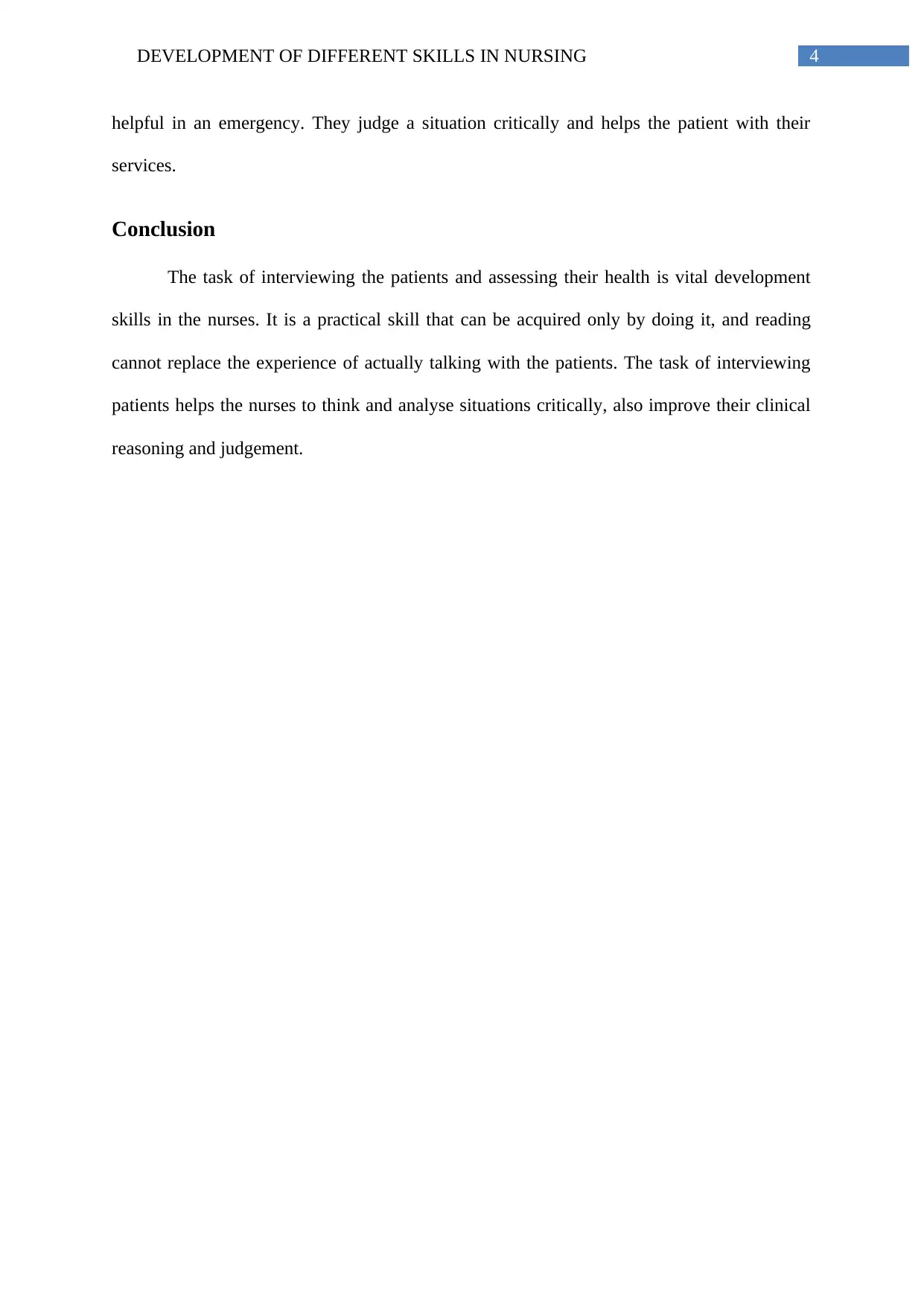
4DEVELOPMENT OF DIFFERENT SKILLS IN NURSING
helpful in an emergency. They judge a situation critically and helps the patient with their
services.
Conclusion
The task of interviewing the patients and assessing their health is vital development
skills in the nurses. It is a practical skill that can be acquired only by doing it, and reading
cannot replace the experience of actually talking with the patients. The task of interviewing
patients helps the nurses to think and analyse situations critically, also improve their clinical
reasoning and judgement.
helpful in an emergency. They judge a situation critically and helps the patient with their
services.
Conclusion
The task of interviewing the patients and assessing their health is vital development
skills in the nurses. It is a practical skill that can be acquired only by doing it, and reading
cannot replace the experience of actually talking with the patients. The task of interviewing
patients helps the nurses to think and analyse situations critically, also improve their clinical
reasoning and judgement.
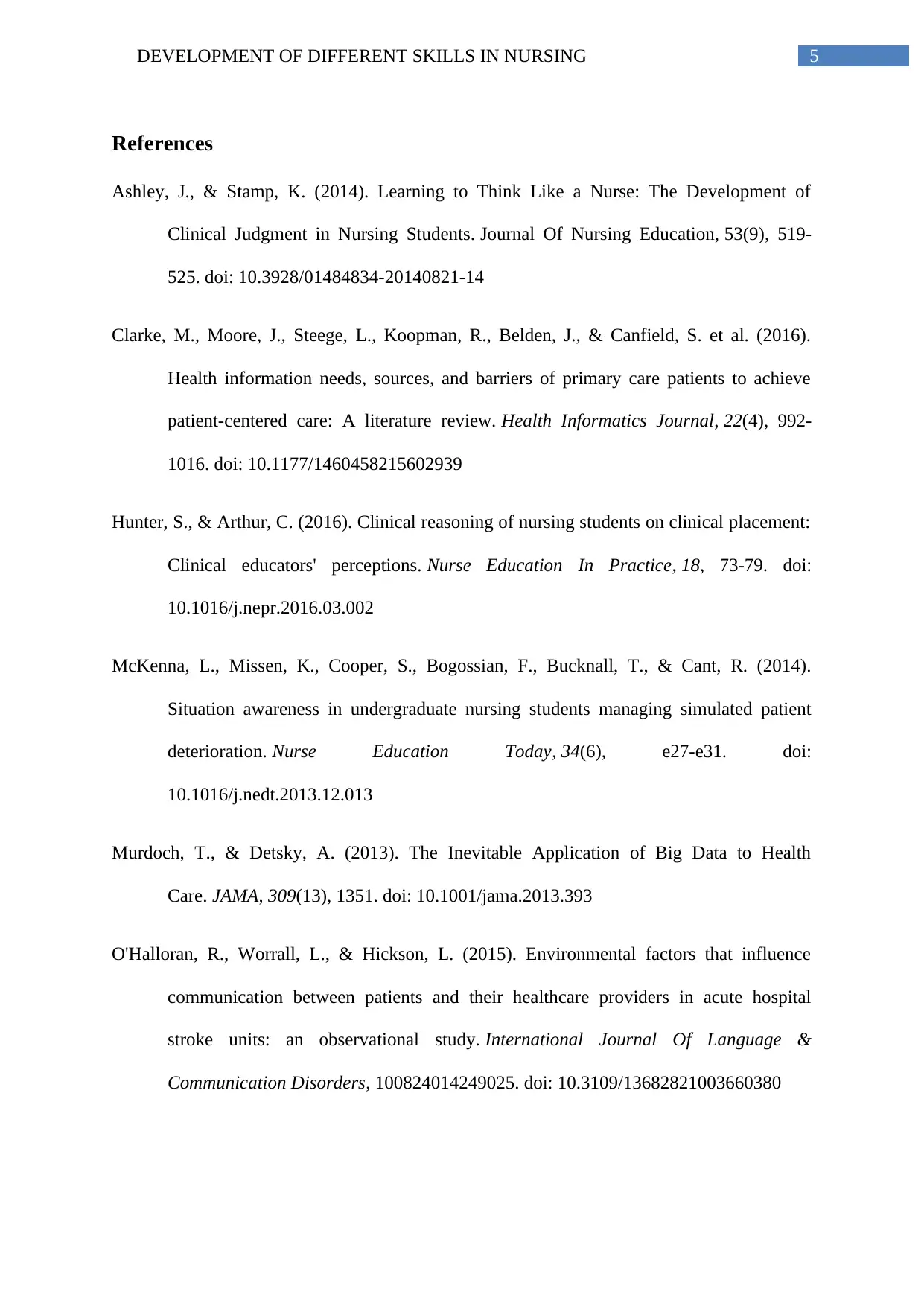
5DEVELOPMENT OF DIFFERENT SKILLS IN NURSING
References
Ashley, J., & Stamp, K. (2014). Learning to Think Like a Nurse: The Development of
Clinical Judgment in Nursing Students. Journal Of Nursing Education, 53(9), 519-
525. doi: 10.3928/01484834-20140821-14
Clarke, M., Moore, J., Steege, L., Koopman, R., Belden, J., & Canfield, S. et al. (2016).
Health information needs, sources, and barriers of primary care patients to achieve
patient-centered care: A literature review. Health Informatics Journal, 22(4), 992-
1016. doi: 10.1177/1460458215602939
Hunter, S., & Arthur, C. (2016). Clinical reasoning of nursing students on clinical placement:
Clinical educators' perceptions. Nurse Education In Practice, 18, 73-79. doi:
10.1016/j.nepr.2016.03.002
McKenna, L., Missen, K., Cooper, S., Bogossian, F., Bucknall, T., & Cant, R. (2014).
Situation awareness in undergraduate nursing students managing simulated patient
deterioration. Nurse Education Today, 34(6), e27-e31. doi:
10.1016/j.nedt.2013.12.013
Murdoch, T., & Detsky, A. (2013). The Inevitable Application of Big Data to Health
Care. JAMA, 309(13), 1351. doi: 10.1001/jama.2013.393
O'Halloran, R., Worrall, L., & Hickson, L. (2015). Environmental factors that influence
communication between patients and their healthcare providers in acute hospital
stroke units: an observational study. International Journal Of Language &
Communication Disorders, 100824014249025. doi: 10.3109/13682821003660380
References
Ashley, J., & Stamp, K. (2014). Learning to Think Like a Nurse: The Development of
Clinical Judgment in Nursing Students. Journal Of Nursing Education, 53(9), 519-
525. doi: 10.3928/01484834-20140821-14
Clarke, M., Moore, J., Steege, L., Koopman, R., Belden, J., & Canfield, S. et al. (2016).
Health information needs, sources, and barriers of primary care patients to achieve
patient-centered care: A literature review. Health Informatics Journal, 22(4), 992-
1016. doi: 10.1177/1460458215602939
Hunter, S., & Arthur, C. (2016). Clinical reasoning of nursing students on clinical placement:
Clinical educators' perceptions. Nurse Education In Practice, 18, 73-79. doi:
10.1016/j.nepr.2016.03.002
McKenna, L., Missen, K., Cooper, S., Bogossian, F., Bucknall, T., & Cant, R. (2014).
Situation awareness in undergraduate nursing students managing simulated patient
deterioration. Nurse Education Today, 34(6), e27-e31. doi:
10.1016/j.nedt.2013.12.013
Murdoch, T., & Detsky, A. (2013). The Inevitable Application of Big Data to Health
Care. JAMA, 309(13), 1351. doi: 10.1001/jama.2013.393
O'Halloran, R., Worrall, L., & Hickson, L. (2015). Environmental factors that influence
communication between patients and their healthcare providers in acute hospital
stroke units: an observational study. International Journal Of Language &
Communication Disorders, 100824014249025. doi: 10.3109/13682821003660380
⊘ This is a preview!⊘
Do you want full access?
Subscribe today to unlock all pages.

Trusted by 1+ million students worldwide
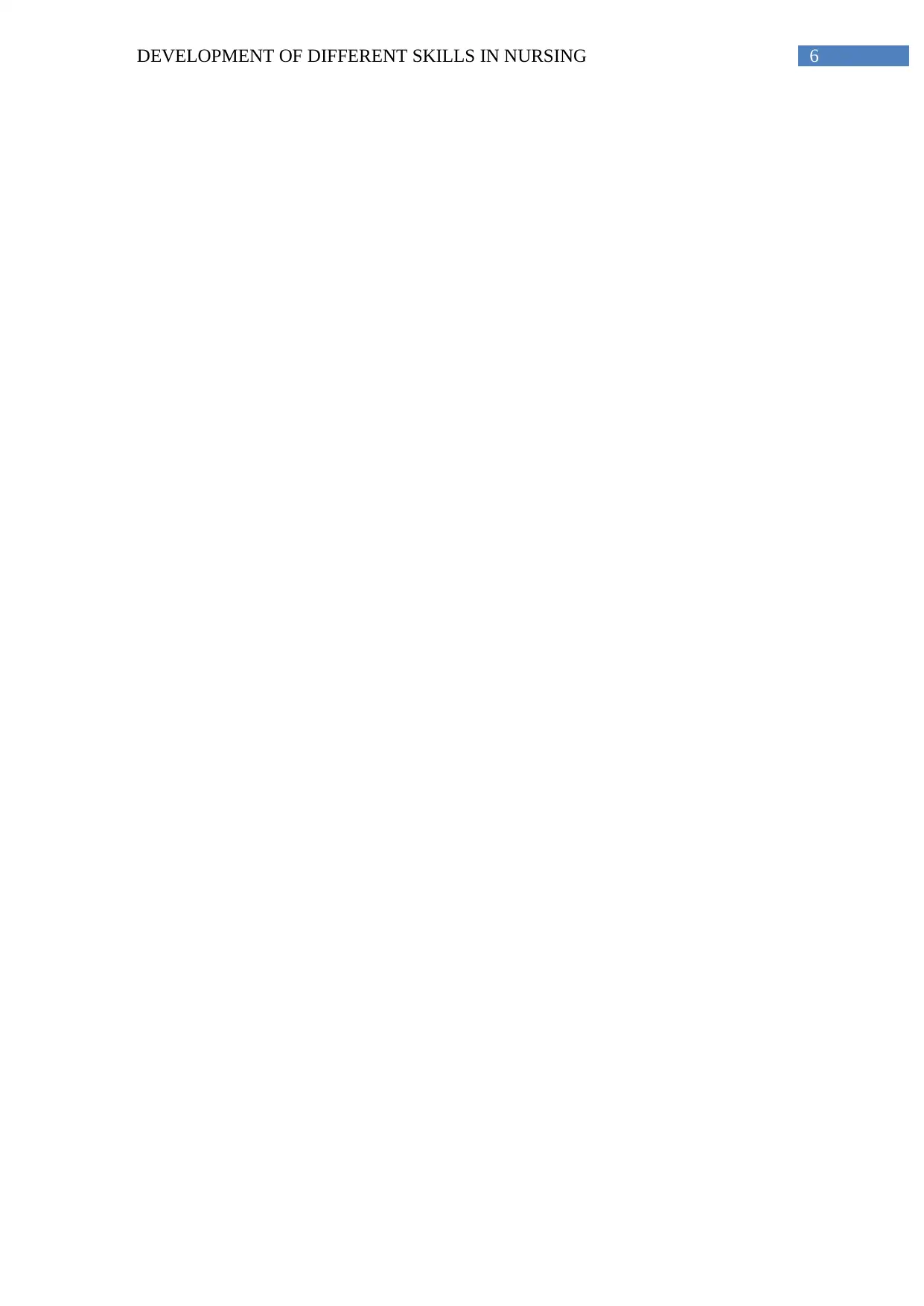
6DEVELOPMENT OF DIFFERENT SKILLS IN NURSING
1 out of 7
Related Documents
Your All-in-One AI-Powered Toolkit for Academic Success.
+13062052269
info@desklib.com
Available 24*7 on WhatsApp / Email
![[object Object]](/_next/static/media/star-bottom.7253800d.svg)
Unlock your academic potential
Copyright © 2020–2025 A2Z Services. All Rights Reserved. Developed and managed by ZUCOL.





